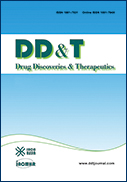Volume 10, Issue 6
Displaying 1-10 of 10 articles from this issue
- |<
- <
- 1
- >
- >|
Reviews
-
2016 Volume 10 Issue 6 Pages 276-284
Published: 2016
Released on J-STAGE: January 15, 2017
Advance online publication: December 18, 2016Download PDF (1295K) -
2016 Volume 10 Issue 6 Pages 285-291
Published: 2016
Released on J-STAGE: January 15, 2017
Advance online publication: October 17, 2016Download PDF (376K) -
2016 Volume 10 Issue 6 Pages 292-299
Published: 2016
Released on J-STAGE: January 15, 2017
Advance online publication: October 17, 2016Download PDF (346K)
Original Articles
-
2016 Volume 10 Issue 6 Pages 300-306
Published: 2016
Released on J-STAGE: January 15, 2017
Advance online publication: October 04, 2016Download PDF (414K) -
2016 Volume 10 Issue 6 Pages 307-313
Published: 2016
Released on J-STAGE: January 15, 2017
Download PDF (996K) -
2016 Volume 10 Issue 6 Pages 314-322
Published: 2016
Released on J-STAGE: January 15, 2017
Advance online publication: October 17, 2016Download PDF (917K) -
2016 Volume 10 Issue 6 Pages 323-328
Published: 2016
Released on J-STAGE: January 15, 2017
Advance online publication: November 27, 2016Download PDF (617K) -
2016 Volume 10 Issue 6 Pages 329-333
Published: 2016
Released on J-STAGE: January 15, 2017
Advance online publication: October 11, 2016Download PDF (535K)
Case Report
-
2016 Volume 10 Issue 6 Pages 334-337
Published: 2016
Released on J-STAGE: January 15, 2017
Advance online publication: December 18, 2016Download PDF (875K)
Letter
-
2016 Volume 10 Issue 6 Pages 338-339
Published: 2016
Released on J-STAGE: January 15, 2017
Download PDF (166K)
- |<
- <
- 1
- >
- >|
